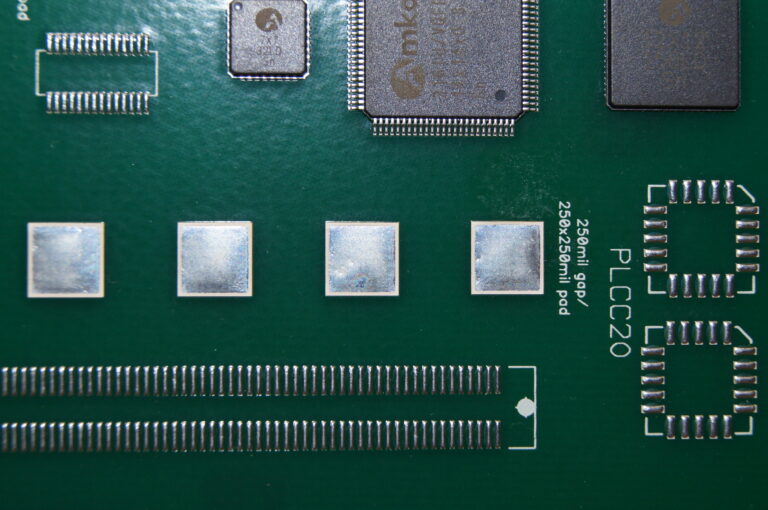申请建议
优化和工程师批准
锡膏处理技巧
在电子制造工艺中,正确处理对于保持锡膏质量和实现最佳效果至关重要。以下是一些运输、储存和准备焊膏的重要提示,以及有关钢网应用和环境条件的建议。
运输和装运提示 #1
尽可能隔夜运输焊膏,以尽量减少暴露在环境条件下的时间,尤其是在炎热潮湿的天气。
运输和装运提示 #2
对于国际运输,由于可能无法提供隔夜运输,因此最长运输时间应为两到三天。避免海运锡膏。
运输和装运提示 #3
在酷热天气、国际运输或对膏体成分极为敏感的情况下,可考虑使用特殊包装材料或加入冰块。
运输和装运提示 #4
请注意,焊膏运输和焊膏储存是不同的。在未冷藏的情况下短时间运输通常不会损坏焊膏。大多数配方都足够坚固,可以在运输过程中经受短暂的非冷藏状态。
存储提示 #1
收到焊膏后立即将其转移到适当的存放区,避免将其留在码头上。
存储提示 #2
在室温(< 25°C 或 < 77°F)下储存焊膏,保质期一般为三至六个月。在 0°C - 12°C (32°F - 55°F) 的温度下冷藏保存,可将保质期延长一倍,同时保护其不受环境波动的影响。
存储提示 #3
不要将新焊膏和用过的焊膏混放在同一个容器中,因为它 将 使新浆糊变质。
准备工作提示 #1
让焊膏自然达到环境(室)温度后再拆封。避免强行加热焊膏。建议在室温下放置一夜(8 小时),以获得最佳效果。
准备工作提示 #2
涂抹前用抹刀轻轻地充分搅拌糊状物一分钟。搅拌可确保因储存而分离的材料均匀分布。胶筒不需要搅拌,因为胶浆从胶筒中喷出时会发生剪切稀化。
预备提示 #3
切勿使用自动搅拌器进行搅拌,否则会破坏浆糊的流变特性。
钢网应用吸头 #1
在印刷周期内,涂抹足够量的焊膏,以获得平滑均匀的滚动效果。大多数钢网的焊膏卷直径通常为 ⅜" 到 ½" (9.5 到 12.5 毫米)。开始时,涂抹两到三倍于所需辊子尺寸的浆糊,以使刮刀均匀分布浆糊。
钢网应用吸头 #2
辊子的长度应与刮刀的长度一致。刮刀应比可印刷区域稍大一些(每边 1/2 英寸或 12.5 毫米)。
钢网应用吸头 #3
以可控的时间间隔向钢网添加少量新鲜焊膏,以保持其化学性质和可加工性。经常少量添加比不经常大量添加要好。
钢网应用吸头 #4
印刷后立即进行 SMT 加工,以防止焊膏在 PCB 上变干。
钢网应用吸头 #5
兼容的钢网底部清洁剂可以延长钢网的印刷寿命。但应避免使用异丙醇(IPA),因为它会使焊膏变质。
应用环境提示 #1
在印刷、填充和回流焊过程中保持稳定的温度和湿度,以获得最佳效果。理想的温度为 22° - 26°C(72° - 80°F),相对湿度为 45% ± 5%,开放/粘合时间可达 24 小时。
应用环境提示 #2
在温度或湿度过高的环境中,焊膏的功能可能会下降得更快,从而导致潜在的缺陷,如坍塌、焊球和粘度变化。

锡膏处理常见问题
最常见的问题和答案
答:一般不建议冷冻焊膏,因为这会导致活化剂从焊膏中析出,从而对润湿和印刷性能产生不利影响。不过,大多数焊膏配方都能在低至 0°C (32°F) 的温度下保持其完整性,并在接近此温度的冷冻条件下正常工作。低于此温度则不可取。
答:通过加热或剧烈搅拌强行加热浆糊会改变其流变特性,并对其性能产生负面影响。
答:焊膏的保质期因具体类型而异,但 AIM 焊膏在室温下存放的保质期一般为 3-6 个月。
答:使用自动搅拌器会产生各种不可预测的力,可能会导致焊膏的粘度和其他特性发生变化,从而对其功能产生不利影响。我们建议只使用手工搅拌。
答:不宜将新焊膏和旧焊膏放在同一个容器中,因为这样会污染未使用的焊膏并使其变质。
答:浆糊开封后不应冷藏。相反,在不使用时,应重新密封任何开封的材料并将其存放在室温下。
答:注射器和针筒最好垂直存放,喷头朝下,以防止助焊剂分离并保持性能稳定。
答:虽然我们不能保证过期牙膏的质量或可用性,但如果您选择在过期后使用,请务必先进行测试,以确定它是否仍然符合您的要求。请记住,使用过期的浆糊可能会产生比节省下来的更多的问题,而且通常丢弃过期浆糊而使用新鲜浆糊会更安全、更经济。
答:处理不当的一个常见迹象是焊膏中的助焊剂和合金分离。其他更细微的迹象可能只表现为制造缺陷。
不同类型或品牌的焊膏具有不同的成分和特性,可能导致无法预测的结果和潜在的性能问题。
答:一般不建议重复使用用剩的焊膏。锡膏可能已经接触到污染物或其成分发生了变化,这可能会影响其性能和可靠性。最好使用新鲜的焊膏,以获得最佳效果。
答:应该扔掉。试图用添加剂来调节粘度是不可能获得合适的焊接效果的。
答:过期或无法使用的焊膏的处置方法可能因当地法规而异。建议向当地政府或废物管理机构咨询正确的处理程序,以确保符合环保准则。您也可以咨询金属回收商,看看是否可以将其与锡渣一起回收。
答:焊膏可用于返修或维修应用,但必须评估焊膏与现有焊料和元件的兼容性。应遵循正确的返修技术和温度曲线,以确保成功和可靠的结果。
答:不可以,除非有制造商提供的兼容性证据。混合会改变浆糊的特性,可能导致性能问题或可靠性问题。
答:虽然现代焊膏一般不再含铅,但仍含有可能有害的其他金属和物质。请遵守安全准则,如穿戴适当的个人防护设备 (PPE),确保工作区通风良好,避免直接接触皮肤或眼睛。有关具体的预防措施和指南,请查阅制造商提供的安全数据表 (SDS)。请记住,焊膏会微量地沾在任何东西上。在离开生产环境时,您可能需要考虑更换衣服和鞋袜。
答:锡膏在非冷藏运输条件下通常可存活 72 小时,不会出现问题。可以用冰袋包装,以确保其完整性。如果冰袋在运抵时已完全融化,不要惊慌。这只是表明这些冰袋起到了吸收多余热量的作用。

